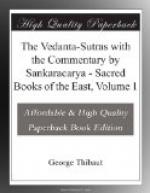INTRODUCTION
Vedanta-sutras with the commentary by sa@NKARACHARYA.
Adhyaya I.
Pada I.
Pada ii.
Pada III.
Pada IV.
Adhyaya ii.
Pada I.
Pada ii.
* * * * *
Transliteration of Oriental Alphabets adopted for the Translations of the Sacred Books of the East.
[Transcriber’s Note: This book contains many words with one or two letters in the word printed in italics; those letters are transcribed by enclosing them in slashes, e.g. “karmaka/nd/a” has the letters “nd” in italics. Also, the symbol “@” is used before the letter “n” to indicate a horizontal bar across the top.]
INTRODUCTION.
To the sacred literature of the Brahmans, in the strict sense of the term, i.e. to the Veda, there belongs a certain number of complementary works without whose assistance the student is, according to Hindu notions, unable to do more than commit the sacred texts to memory. In the first place all Vedic texts must, in order to be understood, be read together with running commentaries such as Saya/n/a’s commentaries on the Sa/m/hitas and Brahma/n/as, and the Bhashyas ascribed to Sa@nkara on the chief Upanishads. But these commentaries do not by themselves conduce to a full comprehension of the contents of the sacred texts, since they confine themselves to explaining the meaning of each detached passage without investigating its relation to other passages, and the whole of which they form part; considerations of the latter kind are at any rate introduced occasionally only. The task of taking a comprehensive view of the contents of the Vedic writings as a whole, of systematising what they present in an unsystematical form, of showing the mutual co-ordination or subordination of single passages and sections, and of reconciling contradictions—which, according to the view of the orthodox commentators, can be apparent only—is allotted to a separate sastra or body of doctrine which is termed Mima/m/sa, i.e. the investigation or enquiry [Greek: kat ezochaen], viz. the enquiry into the connected meaning of the sacred texts.
Of this Mima/m/sa two branches have to be distinguished, the so-called earlier (purva) Mima/m/sa, and the later (uttara) Mima/m/sa. The former undertakes to systematise the karmaka/nd/a, i.e. that entire portion of the Veda which is concerned with action, pre-eminently sacrificial action, and which comprises the Sa/m/hitas and the Brahma/n/as exclusive of the Ara/n/yaka portions; the latter performs the same service with regard to the so-called j/n/anaka/nd/a, i.e. that part of the Vedic writings which includes the Ara/n/yaka portions of the Brahma/n/as, and a number of detached treatises called Upanishads. Its subject is not action but knowledge, viz. the knowledge of Brahman.




